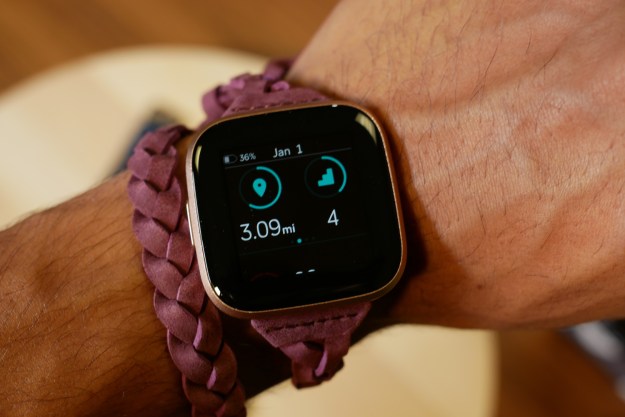
Which one do you want to burden with an ugly, data-gathering gizmo?
There’s a paradigm shift happening in the tech world, and design is at the center of it, Amit argued Tuesday at the Designers of Things Conference, a two-day event dedicated to wearables, 3D printing, and the Internet of Things. Amit’s team has worked on some beautifully engineered gear, including the Fitbit, the Lytro camera, and the modular Project Ara smartphone from Google. For enthusiasts, the best technology has been utilitarian, functional, and maybe minimalist. But now we’re dealing with a phenomenon that needs to go past minimalism; people are becoming emotionally connected to their devices. Yet most are just collecting “data clutter” and very few people want only data. Most want it filtered and presented in an way that lets them make the right decisions.
We need to move from smart devices to wise devices.
Designing the Human Way
The question is how to create objects that are relevant on a human level — something that substantiates our emotional needs without alienating ourselves from our natural environment. Without this, you get Google Glass, an object more about data than experience. In fact, the majority of wearables today are now designed to create a stream of data. They’re called smart but aren’t actually smart, argues Amit.
Size does in fact matter — wrist size, that is. There’s huge variation among individuals.
With all these challenges in mind, it takes more than a designer furiously sketching away on a piece of paper for an idea to become a thing. Finding just the right form factor takes exhaustive modeling and experimentation – and a little intuition doesn’t hurt, either. The reward? Creating a device that inspires an emotional attachment in people. An object that they actually use and don’t throw out for the newest model in two years.
Wearables and Your Health
Beyond Amit’s keynote, there was plenty of debate at Designers of Things; unsurprisingly, one of the prevailing themes was wearables in relation to health. On the biometric clothing front, we had representatives from Hexoskin to give a history lesson on the technologically enhanced shirt. Who knew that the first came from NASA’s Human Factors Group in 1985?
Hexoskin’s gents rightfully pointed out that similar garments from the past three decades have been unfashionable and difficult to fit into one’s day-to-day life. Current designs are much improved, however, and there’s no denying biometric clothing’s usefulness in gathering health data, especially given always-on connectivity and improved battery efficiency. It’s certainly much more effective than individuals keeping health journals or attempting to use devices designed for medical professionals.
Naturally, no conversation on digital health would be complete without thoughts from FitBit, MyFitnessPal and FitStar — and event organizers threw together a panel of the three at the last minute. The panel addressed whether steps are truly a good indicator of health, and the consensus was that steps are better than knowing nothing at all. Also, steps will be around for a lot longer, since they’re easy data points to capture and digest.
Biometric information beyond steps is valuable data but much more technical; the next step should be building systems that take that data and help the user understand it and what it means — in a simple way. In the same way, we’ll see tracking of protein, carbs, and sugar become more important than just calories.
Wearables are becoming palatable for a wider range of people, the panelists noted. We’re not in the high-fashion world quite yet, but there’s a thousand ways to skin a cat and turn it into a tracker. Adding to this point (not the cat part) was Nick Warnoph of Wellograph, maker of an arguably fashionable smartwatch that’s fitted with a curved sapphire crystal. Warnoph pointed out the trend of luxury brands pairing with technology companies as an indicator of where wearables are headed; namely, new materials, new looks and new lines, as evidenced by the Tory Burch for FitBit. (Maybe we are talking high-fashion after all.)
3D Printing and the Internet of Really Cool Things
Whether you’re a practicing designer or just want to be one, there’s no denying the appeal of 3D printing. Thanks to agile manufacturing, you can makes things as custom or as complex as your heart desires — with no increase to cost or time to shipment. And as representatives from Shapeways astutely pointed out, this is just part of the benefit of 3D printing. Another: supply exactly meets demand. If you have 103 orders for a product on Kickstarter, you can fulfill exactly 103 orders, not-a-one more.
Plus you can create accessories that are backwards compatible with older models of gadgets, and replace and repair parts on existing items with ease and experiment with zero risk.
The downside? Now people can pirate physical items as they could with digital items years ago. However, if people (and brands) recognize that creativity (not to mention more profits) comes from collaboration, it could be awesome for everyone.
In other words, the Internet of Things will lend to an Internet of really cool things — that we can hold in our hands.
Editors' Recommendations
- The best wearable tech of CES 2022
- Wearables at Google I/O 2021: Everything new announced today
- What is a pulse oximeter, and why should you care?
- Wearable device can tell if your cough is the coronavirus
- Fitbit wants to find out if wearables can detect coronavirus

